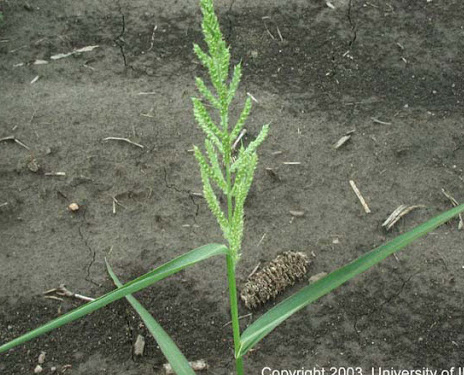Controlling Summer Annual Grassy Weeds in Lawns

Crabgrass
As we enter the summer season, you might notice some new outlaws sauntering onto your lawn. Gone are the turf weeds of late winter and early spring, such as hairy bittercress and chickweed. A new crop is in town, the “summer annuals.” What are summer annual turfgrass weeds, and what can you do about them? This Article discusses some of the more common summer annual weeds found in our lawns that have a grass-like appearance, sometimes referred to as “annual grasses” or, as here, “grassy weeds.”
Summer annuals germinate in spring and grow until the first frost, completing their life cycle in one season. The self-seeding grassy weeds discussed here produce copious quantities of seed that, once dispersed, remain dormant in the soil in winter, ready to sprout when warm weather returns. While we might not ever be able to beat these formidable yard nuisances, we can control them.
Types of grassy weeds

Goosegrass
Crabgrass lookalikes include goosegrass (Eleusine indica). Goosegrass sprouts about a month later than crabgrass because its seeds require somewhat warmer temperatures for germination. If you successfully reined in your crabgrass early in the season, only to see it mysteriously reappear, you might in fact be looking at goosegrass. Goosegrass features a tight center rosette and silvery or whitish flattened sheaths. Viewed from above, it looks like spokes from a central hub.

Barnyardgrass
Another crabgrass lookalike, the foxtails, including yellow foxtail (Setaria pumila), features long leaf blades and erect, red-tinged stems. It is the last of the grassy weeds discussed here to germinate, requiring soil temperatures of about 65 degrees. Foxtails can grow in moist or dry soils and tolerate a wide range of environmental conditions. Don’t fret if you’re not sure which of these weeds is what because most are controlled in the same way.

Japanese Stiltgrass
Control of grassy weeds
If your weeds are few and far between, pluck them by hand. Summer annual grassy weeds (especially stiltgrass) are among the easiest to pull because they usually lack creeping stems that root. Some might think that a close buzz with a mower (fitted with a catch bag) will nip off the seed heads of a mature plant, but crabgrass can produce seed even in very short turf. Also, mowing low will expose seeds already in the soil to sunlight, encouraging germination.
Chemical controls are also available. Look for products with the active ingredients mesotrione, fenoxaprop, fluazifop, or sethoxydim, which will control most of these weeds. Quinclorac controls crabgrass, but not goosegrass. (Pre-emergent controls are another option, although summer is not the season to apply them. Those controls must be applied before seeds sprout. Crabgrass pre-emergents should be applied in our area in mid-March.) The more mature your grassy weeds, and the denser and more prevalent they are, the more difficult it will be to control them with chemicals. Repeated applications may be required. As with any pesticide, users of herbicides are required by law to follow the product label.
The best control is to maintain healthy turf in the first place. Vigorous turf inhibits seed germination by shading seeds already present, while turf struggling in poor soil or shade gives these weeds an opportunity to germinate — giving space and sunlight settle in. Avoid fertilizing your lawn when weeds are sprouting; you don’t want to feed them. Also, water your lawn, as necessary, with deep, infrequent watering, which aids turfgrasses with deeper roots, and avoid light, infrequent watering that will benefit short-rooted weeds.
References
• Spring and Summer Lawn Management Considerations for Cool-Season Turfgrasses, Virginia
Cooperative Extension Publication 430-532
• Best Management Practices in Spring Crabgrass Control in Lawns, Virginia Cooperative Extension
• Summer Grassy Weed Control in Lawns, Virginia Cooperative Extension
• Crabgrass – A Real Pain in the Grass!, Virginia Cooperative Extension
• Top 5 Weeds — Headaches in our Summer Lawns, Sharon V. Smith, Fairfax Gardening
• We Don’t Have Enough Weeds, Barbara Shepard, Fairfax Gardening
• Pest Management Guide, Home Grounds and Ornamentals, 2020, Virginia Cooperative Extension,
Section 5, Lawn: Weeds and Table 5.7
• Japanese Stiltgrass Control in the Home Lawn and Landscape, New Jersey Agricultural Experiment
Station Cooperative Extension (Rutgers) Fact Sheet FS1237
• Japanese Stiltgrass, United States Department of Agriculture, U.S. Forest Service
• Biology and Management of Crabgrass, University of Massachusetts Extension
• Summer Annual Weeds, Missouri Botanical Garden